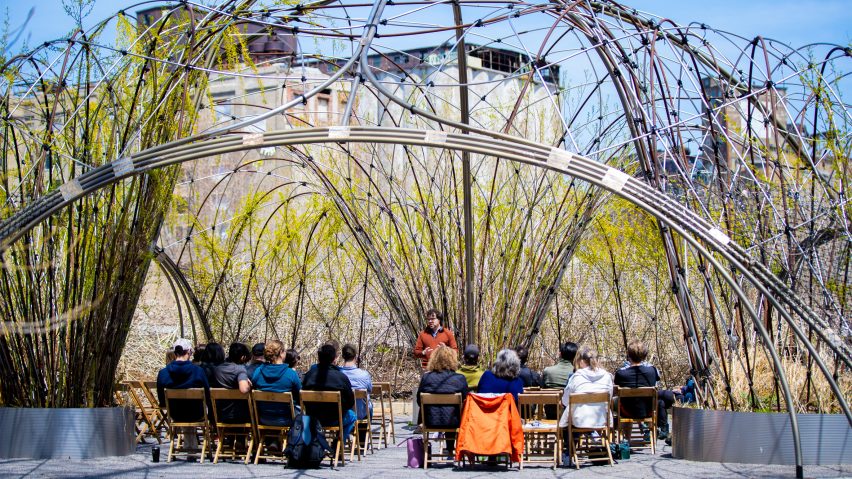
University at Buffalo spotlights 10 student architecture projects
Dezeen School Shows: a project that uses mycelium as a design tool and housing to accommodate immigrants are included in Dezeen's latest school show by students at the University at Buffalo.
Also included is a queer exhibition space reflecting on the history of Buffalo and a trellis designed to regenerate the landscape.
University at Buffalo
School: School of Architecture and Planning
Course: Graduate and undergraduate programmes
Tutors: Nicholas Bruscia, Mark Shepard, Cody Mejeur, Christopher Romano, Randy Fernando, Brian Carter, Maia Peck, Adam Thibodeaux, Kerry Traynor, Erkin Özay, Annette LeCuyer, Laura Lubniewski, Bradley Wales, Stephanie Cramer, Nicholas Rajkovich, Joyce Hwang, Laura Garófalo, Kenneth Mackay, Elaine Chow, Julia Jamrozik, Jon Spielman, Seth Amman and Justina Zifchock
School statement:
"The University at Buffalo School of Architecture and Planning embraces the grand global challenges of the day as openings for radical action towards more just, resilient and enriching communities for all.
"Its deep-rooted traditions in hands-on, activist teaching and research situate student work in the surrounding community and translates ideas into built works and realised plans.
"Embedded in the City of Buffalo, on the western edge of New York State, the school engages the transitioning landscapes of its host city in globally relevant investigations in inclusive design, food systems planning, community-based economic development, climate-resilient design, and sustainable housing.
"Top-ranked for research among its peers in the Association of American Universities, the school collaborates with industry and across the disciplines at the University at Buffalo, a flagship of the State University of New York (SUNY).
"Degree offerings at the bachelor's, master's and doctoral levels include a BS in Architecture, a nationally accredited Master of Architecture and Master of Urban Planning, SUNY's only MS in Real Estate Development, specialised degrees in affordable housing and historic preservation and a newly launched MS in International Development and Global Health."
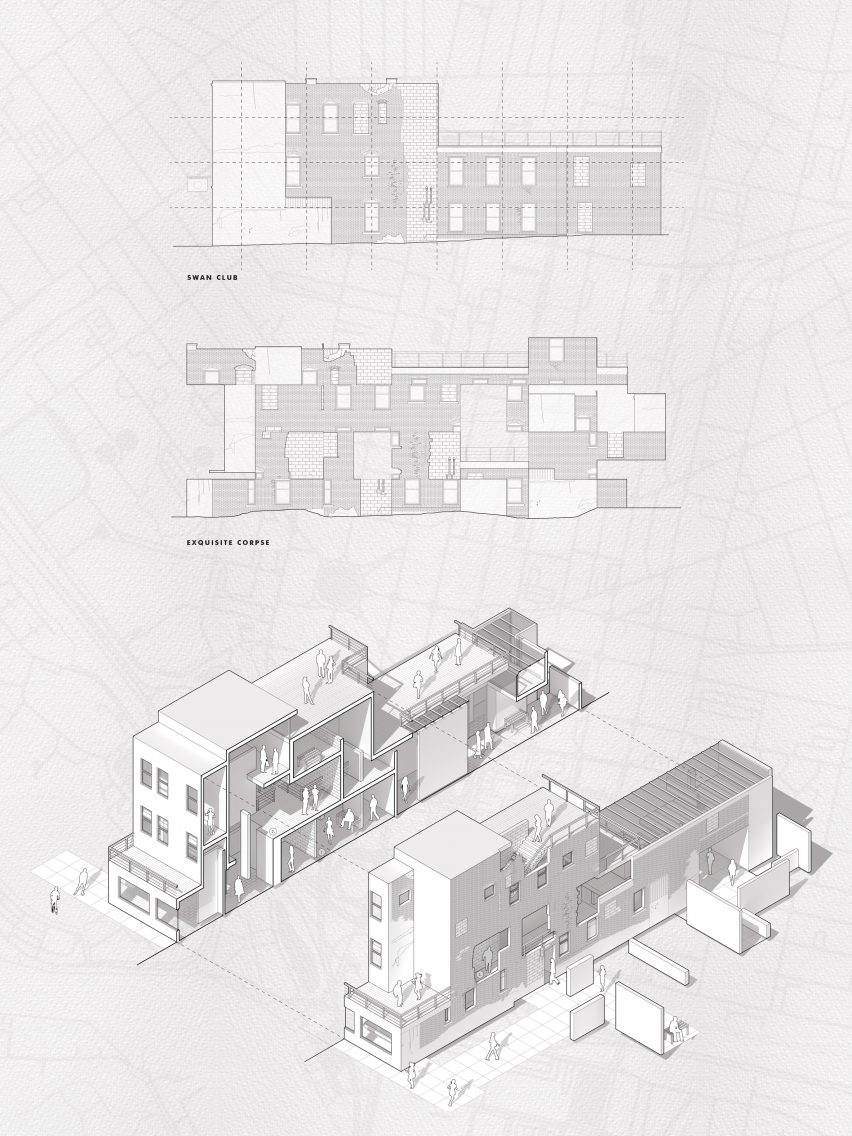
Lost Histories by Christopher Sweeney
"437 Ellicott Street in Buffalo, New York, has a small window of queer history inside its walls, housing the popular Swan Club in the early 1980s.
"Today, the site is a high-end restaurant, without a trace of the Swan Club's existence. What happened to the voices of those who frequented the Swan Club?
"The recent demolition of an adjacent building both physically reveals the site while inviting an exploration of this history of erasure in LGBTQ communities.
"Lost Histories reimagines 437 Ellicott as an exhibition space for physical fragments of demolished queer spaces in Buffalo, alongside the names of those who died during the AIDS epidemic, as recorded in The Madeline Davis LGBTQ Archive."
Student: Christopher Sweeney
Course: Master of Architecture, Inclusive Design Research Group
Tutor: Adam Thibodeaux
Email: clsween[at]buffalo.edu
Architect and the Gamification of Design Experience by Anna Mytcul
"An investigation of gaming as a framework for design democratisation in architecture, Architect is a multi-sensory game exploring the educational aspects of learning games and their influence on end-user engagement in house co-design.
"This combinatorial game employs an augmented reality application that converts architectural drawings into 3D models in real time with integrated design evaluation.
"By allowing for learning through play, Architect provides alternative modes of design education that empower non-experts to shape their future urban environments at a micro scale.
"Free access to the Architect platform rethinks conventional market relations and explores emerging personal and public values, ultimately extending architectural literacy to less-privileged communities."
Student: Anna Mytcul
Course: Master of Architecture, Thesis/Directed Research
Tutors: Nicholas Bruscia, Mark Shepard and Cody Mejeur
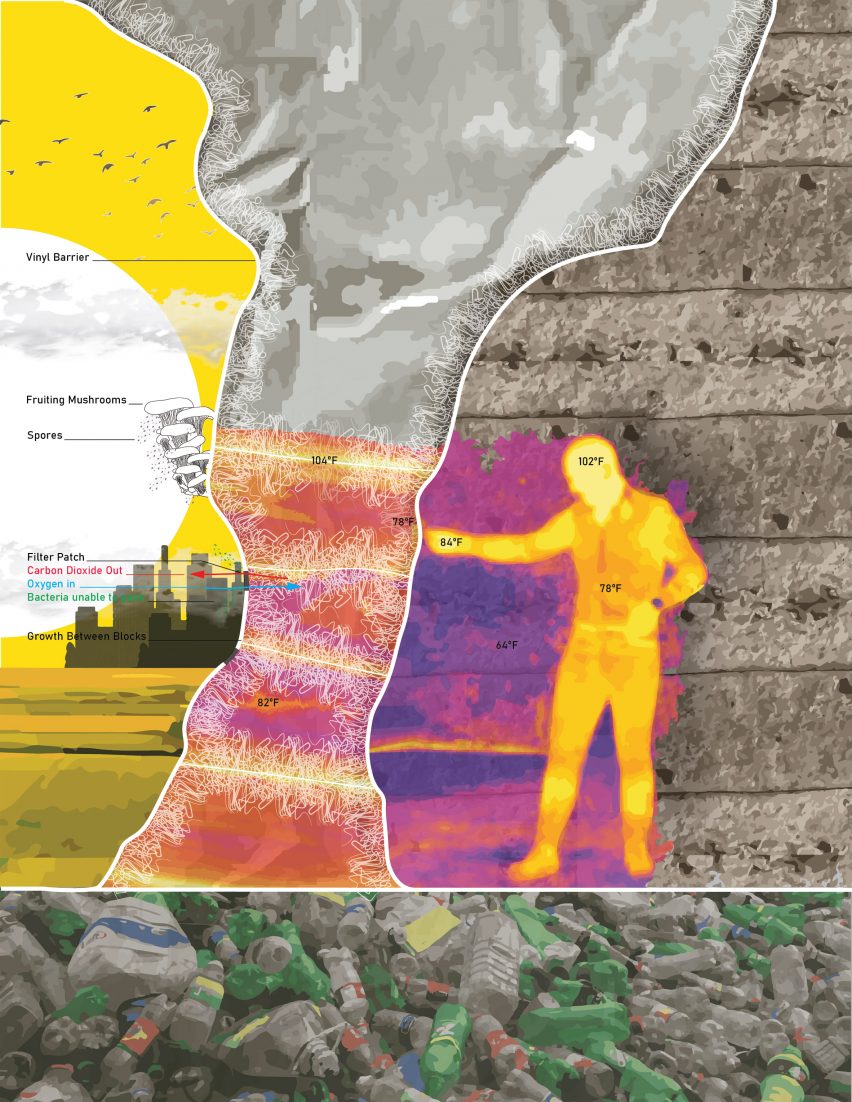
There's A Bag Between Us by Rocco Battista
"There's a Bag Between Us explores the potential of fungi as part of a built interface between humans and the natural environment, bringing us closer to a state of harmony with the planet.
"Mycelium, the root structure of mushrooms, interlaces natural ecosystems and aids in the allocation of nutrients between plants.
"Just as our atmosphere maintains specific conditions for human life, mycelium grown under human influence requires a micro climate through the use of a sealed bag.
"By fusing mycelium-based bio-composites with wood – and documenting the required micro and macro climate conditions within and outside the bag – the project will generate monolithic aggregations of mycelium-based building blocks."
Student: Rocco Battista
Course: Master of Architecture, Thesis/Directed Research
Tutors: Christopher Romano and Randy Fernando
Email: roccobat[at]buffalo.edu
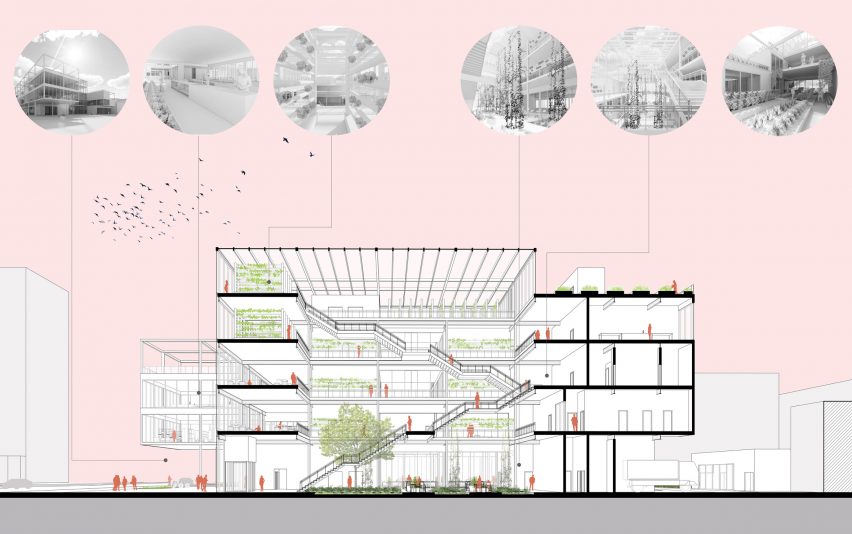
Buffalo Food School by Hali Sheriff
"The Buffalo Food School supports community health as a centre for year-round food harvesting, production and education.
"Designed to provide diverse growing conditions, the building is oriented to maximise sun capture in the winter months and features varying conditions of light and shade throughout.
"A vertical hydroponics system fills the main circulation area and top floor. Public and semi-public spaces on the first and second levels transition to kitchen classrooms and learning spaces on the third and fourth floors that link to outdoor growing areas.
"All harvests are distributed through the building's central food market that serves residents as well as daycare centres, nursing homes and homeless shelters in the surrounding community."
Student: Hali Sheriff
Course: 3.5 year Master of Architecture
Tutors: Brian Carter and Maia Peck
Email: halisher[at]buffalo.edu
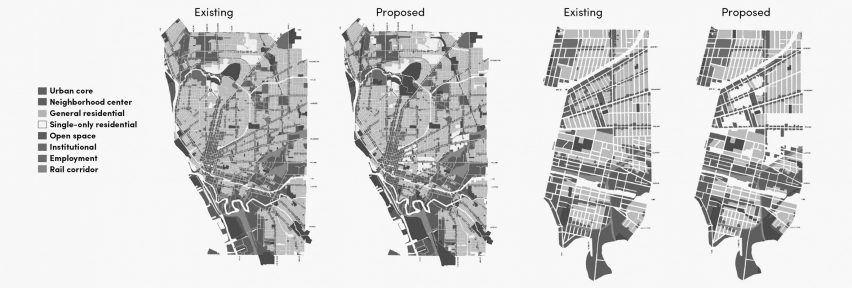
Convergent Histories on Broadway by Grace Bird, Sergy Dossous, Charlon Foster, Ted Griswold, Sarah Martin, Joshua McClain, Nathanial Mich, Tyson Morton, Annalyse Paulson, Michael Santoro, Valerie Weisbeck and Bree Zuchowski
"This studio considers how we preserve and interpret spaces where the material fabric has been destroyed, often by policies and programs that target marginalised communities.
"Engaging students in architecture, urban planning and real estate development, the studio makes recommendations for the reuse of a former armoury and offers an interpretive plan for the surrounding Pratt-Willert neighbourhood, the historic centre of Buffalo's Black community.
"Combining archival analysis of segregationist policy and Negro Motorist Green Books (published to help Black travellers navigate segregation during the Jim Crow Era) with current demographic and market research, students developed zoning and land use proposals as well as pro forma that respect the area's historic legacy while meeting the current needs of the community."
Students: Grace Bird, Sergy Dossous, Charlon Foster, Ted Griswold, Sarah Martin, Joshua McClain, Nathanial Mich, Tyson Morton, Annalyse Paulson, Michael Santoro, Valerie Weisbeck and Bree Zuchowski
Course: Preservation Planning Studio: Master of Urban Planning, MS in Real Estate Development, MS in Architecture Architecture
Tutor: Kerry Traynor
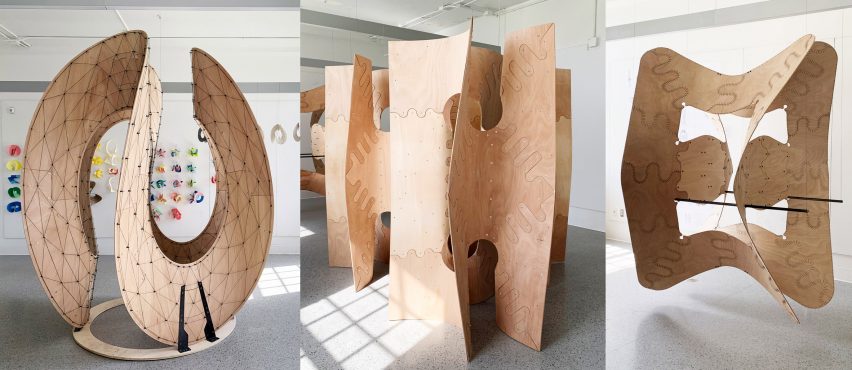
Figure to Fibre by Tyler Beerse, Ollie He, Jamie Jones, Bhalendu Guatam, Marissa Hayden, Josh Barzideh, Tom Cleary, Sam Goembel, Lovepreet Kaur, Nick Hills, Camilo Copete, Ben Starr
"Three large prototypes were built – three ellipses, 18 squares and eight triangles – from two layers of three millimetre thick plywood sheets.
"Since the seams between parts never align between layers, bending can occur naturally without an awkward accumulation of thickness.
"The natural wood grain is strategically oriented to the structure's geometry, allowing tighter bending radii and increased stiffness where necessary.
"Since the topology dictates form, and wood tends toward flatness, the internal bending stresses are distributed evenly when the structure is complete.
"Within the acknowledgement of natural occurrence, we find inspiration for synthetic acts as the materialisation of the disclination translates into form-making and fabrication techniques with broad architectural applications."
Students: Tyler Beerse, Ollie He, Jamie Jones, Bhalendu Guatam, Marissa Hayden, Josh Barzideh, Tom Cleary, Sam Goembel, Lovepreet Kaur, Nick Hills, Camilo Copete, Ben Starr
Course: Master of Architecture, Situated Technologies Research Group
Tutor: Nicholas Bruscia
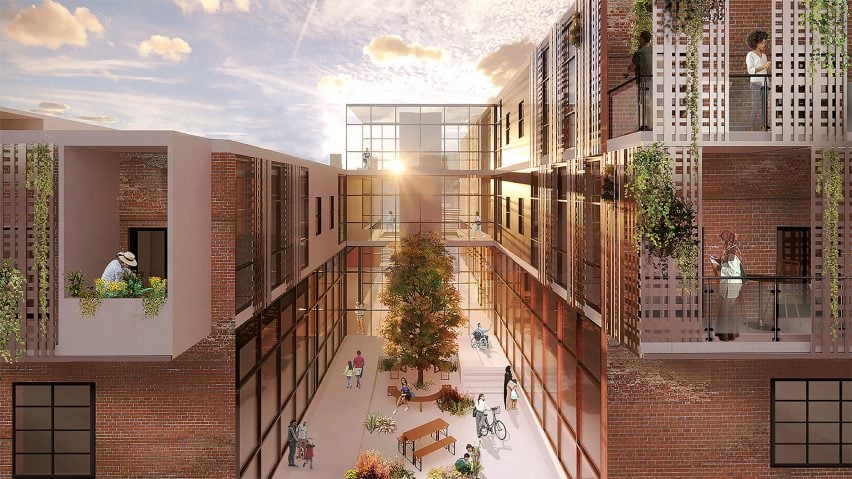
Patchwork by Lauren Herran and Abdulquddus Mohammad
"Patchwork was inspired by Lauren and Adbul's personal experiences and identification with emerging immigrant and refugee populations on Buffalo's East Side.
"Known as the City of Good Neighbours, Buffalo has welcomed an influx of new Americans over the past decade. Patchwork combines flexibility and affordability in housing to accommodate the varying family structures of immigrants, while providing resources and supports for emplacement.
"For instance, multi-use space on the ground floor can be used for vendors during the day and community events in the evening. Additionally, an in-unit track system allows residents to change the layout based on their preferences or circumstances."
Students: Lauren Herran and Abdulquddus Mohammad
Course: Bachelor of Science in Architecture (Senior Housing Studio)
Tutors: Erkin Özay, Nicholas Bruscia, Annette LeCuyer, Laura Lubniewski and Bradley Wales
Emails: lherran[at]buffalo.edu and abdulqud[at]buffalo.edu
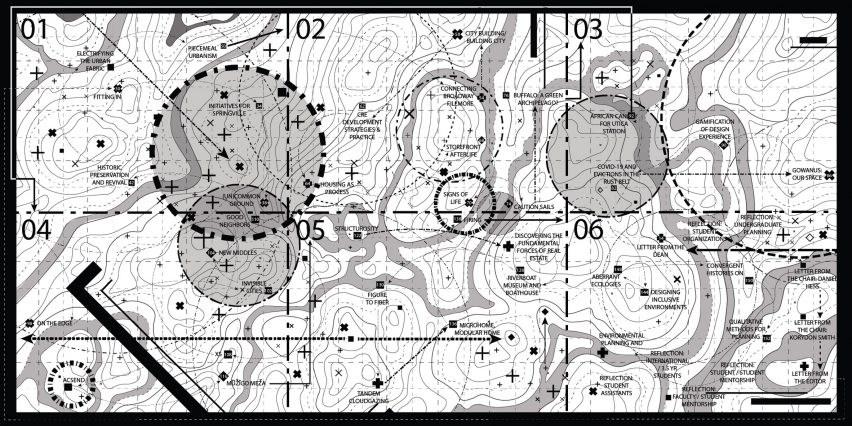
Intersight 24 by Katelyn Broat
"Intersight 24 (IS24), our annual journal of student work, chronicles the creative output of the School of Architecture and Planning as we returned to campus after nearly two years of separation due to the Covid-19 pandemic.
"Katelyn Broat, our 2021-22 Brunkow Fellow and editor of IS24, seizes the opportunity presented by this context, approaching the book's curation as an ethnographic exploration of the social, intellectual and physical relationships that sustain our school community.
"Through meticulous research including interviews with faculty and students, Broat documents a layered thematic landscape across 37 student works, from studios and seminars to competition entries and independent research."
Student: Katelyn Broat
Course: Intersight
Tutors: Stephanie Cramer, Nicholas Bruscia and Wes Grooms
Email: kmbroat[at]buffalo.edu
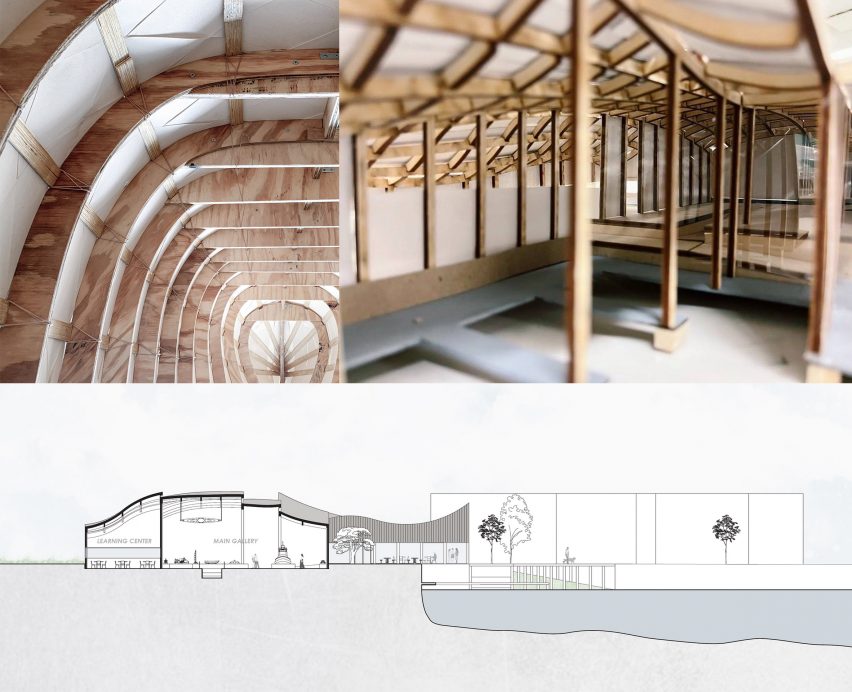
Boattega Veneta and The Current by Mariella Hirschoff
"Inspired by Native American Bull boats, Boattega Veneta – developed by Hirschoff along with a team of students – weaves canvas over a wooden frame using a range of fastening systems: from twine to self-structuring techniques to hardware.
"The boat's ribbed frame and organic material as well as the flow of water are incorporated into Hirschoff's final project, The Current, which features an undulating roof that shifts in height according to the programs within.
"Integrated with the Erie Canal shoreline, The Current houses a cafe, gift shop, main gallery, learning centre, conservation workshop and an enclosed wet dock, with public docks, a bridge, outdoor terrace and publicly accessible green spaces."
Student: Mariella Hirschoff
Course: Bachelor of Science in Architecture
Tutors: Kenneth Mackay, Elaine Chow, Julia Jamrozik, Jon Spielman, Seth Amman and Justina Zifchock
Email: mariella[at]buffalo.edu
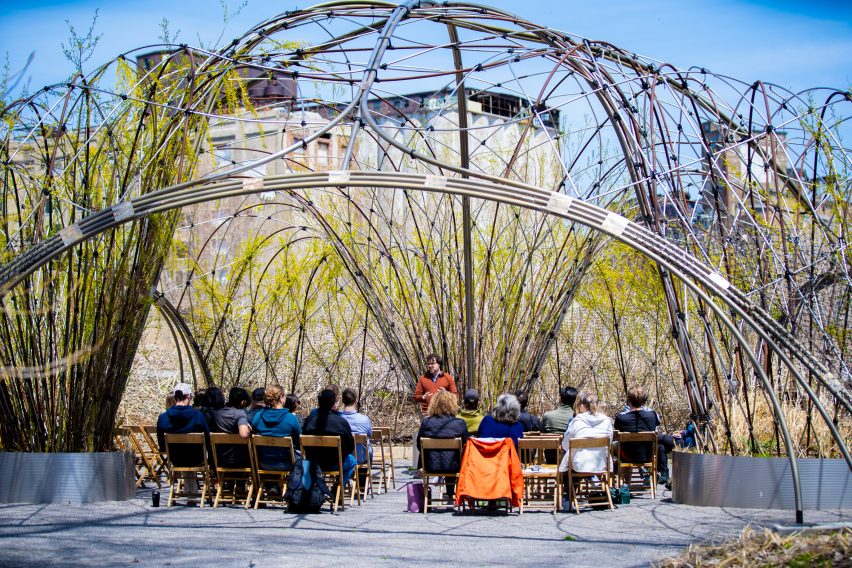
Trellis at Silo City by Ecological Practices design studios
"The Trellis at Silo City is a landscape intervention that was designed by a series of architecture studios as a structural and spatial framework to shape willow trees and other plants into a living canopy that regenerates the post-industrial landscape.
"Set against the City of Buffalo's historic grain elevators, the structure is a 60-foot diameter dome constructed from salvaged stainless steel tubing and concrete.
"Using permaculture techniques, the system smothers invasive species while creating nutrient-rich soil for the willows and native plants.
"Since opening in 2021, the Trellis at Silo City has become a popular destination for cultural activities and outdoor community gatherings, emerging as living infrastructure for the city’s human and non-human residents."
Group project: Master of Architecture, Ecological Practices Research Group
Tutors: Nicholas Rajkovich, Joyce Hwang and Laura Garófalo
Partnership content
This school show is a partnership between Dezeen and the University of Buffalo. Find out more about Dezeen partnership content here.